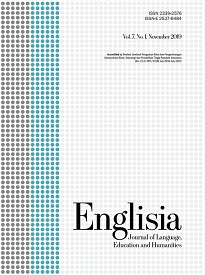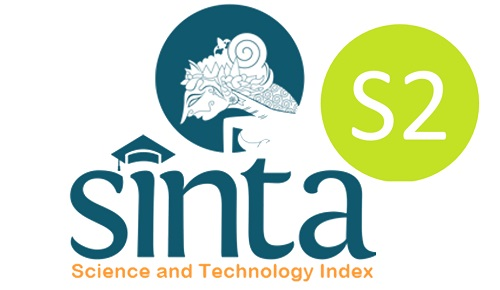VISUALIZATION AND COMPREHENSION: Corroborating children’s reading ability
DOI:
https://doi.org/10.22373/ej.v7i1.4508Keywords:
Reading comprehension, visualization, inference, details, vocabularyAbstract
This study aimed at finding out the influence of visualization on students’ reading comprehension ability. Quantitative approach was employed in carrying out this research. The data were collected through test as it was the main instrument of this study. The data analysis was carried out using manual statistics calculation to find out the mean score before and after the treatment. From the result, it was obtained that the most effect that visualization has is on the inferring; second, it is on details; then it is followed by main idea. The smallest influence is made on vocabulary. Thus, it can be concluded that visualization while reading can help students a lot in terms of inferring, details, and main idea.Downloads
References
Alex, A. (2010, March 7). Between English and Indonesia. Retrieved from http://www.proz.com/translation-articles/articles/2912/1/Between-English-and-Indonesian.
Anderson, N. (2001). Reading in practical English language teaching. New York, NY: McGraw Hill.
Beck, I. L., McKeown, M. G. & Kucan, L. (2013). Bringing words to life. New York, NY: The Guilford Press.
Cary, S. (2004). Going graphic: Comics at work in the multilingual classroom. Portsmouth, NH: Heineman.
Cohen, E. G., Celeste M. B., & Mara. S. (2004). Teaching cooperative learning: The challenge for teacher education. Albany, NY: University of New York Press.
Coiro, J. (2011). Talking about reading as thinking: Modeling the hidden complexities of online reading comprehension. Theory into Practice, 50(2), 107-115.
Cunningham, A., & Stanovich, K. (2003). Reading can make you smarter! New York, NY: H.W Wilson Company.
Duke, N. K., & Pearson, P. D. (2002). Effective practices for developing reading comprehension. In A. E. Farstrup & S. J. Samuel (Eds.), What research has to say about reading instruction (3rd Edition, pp. 205-242). Newark, DE: International Reading Association.
Elosua, M.R., García-Madruga, J. A., Vila, J. O., Gómez-Veiga, I., & Gil, L. (2012). Improving reading comprehension: From metacognitive intervention on strategies to the intervention on working memory executive processes. Ciencia Cognitiva, 12(5), 1425-1438.
Davis, A. J., (2011). Building comprehension strategies for the primary years. Melbourne, Australia: Eleanor Curtain Publishing.
Derrick, J. (2008). Using comics with ESL/EFL students. The Internet TESL Journal. 14(7). Retrieved from http://iteslj.org/Techniques/Derrick-UsingComics.html.
Drolet, A. (2010). Using comics in the development of EFL reading and writing. TESOL Review, 123, 140-150.
Furi, D. (2015). Improving students’ reading comprehension through visualization strategy. (Unpublished bachelor’s thesis). Slamet Riyadi University, Surakarta, Indonesia.
Gambrell, L.B. (2011). Creating classroom cultures that foster reading motivation. The Reading Teacher, 50(1), 14–25.
Gear, A. (2008). Nonfiction reading power. Ontario, Canada: Pembroke Publishers.
Hedgcock, J. S., & Ferris, D. R. (2009). Teaching readers of English: Students, texts, and contexts. New York, NY: Routledge.
Johnson, D. W., Johnson, R. T., & Holubec, E. J. (2008). Cooperation in the classroom. Edina, MN: Interaction Book Co.
Kispal, A. (2008). Effective teaching of inference skills for reading (Research Report DCSF-RR031). Cheshire, United Kingdom: National Foundation for Educational Research, Department of Education (Division of Children, School and Families).
Merc, A. (2013). The effect of comic strip use on reading comprehension of EFL students. International Journal on New Trends in Education and Their Implications. 4(1), 54-64.
Mikulecky, B. S., & Jeffries, L. (1996). More reading power. New York, NY: Addison-Wesley Publishing Company. Inc.
Morrison, T. G., Bryan, G. & Chilcoat, G. W. (2002). Using student-generated comic-books in the classroom. Journal of Adolescent & Adult Literacy, 45(8), 758-767.
Moses, L. (2015). The role(s) of image for young bilinguals reading multimodal informational texts. Language and Literacy, 17(3), 82-99.
Nation, K. (2004). Childrens’ reading. Journal of Adolescent & Adult Literacy. 2(2), 248-265.
Ness, M. K. (2009). Reading comprehension strategies in secondary content area classrooms: Teacher use of and attitudes towards reading comprehension instruction. Reading Horizons, 49(2), 58-85.
Nunan, D. (2004). Research method in language learning. New York, NY: McGraw Hill.
Pearson, P. D., & Cervetti, G. N. (2013). The psychology and pedagogy of reading processes. In W. Reynolds & G. Miller (Eds.), Handbook of Psychology, Educational Psychology (2nd Ed). New York, NY: John Wiley & Sons.
Schmitt, N. (2009). Instructed second language vocabulary learning. Language Teaching Research 12, 329.
Smith, A. (2006). Teaching with comics: Everything you need to know to start teaching with comics. Lethbridge, Canada: University of Lethbridge.
Sugiyono. (2007). Statistika untuk penelitian. Bandung, Indonesia: Alfabeta.
Tienmensma, L. (2009). Visual literacy: to comic or not to comic? Promoting literacy using comic. Italy: Word Library and Information Congress 75th IFLA General Conference and Council. Retrieved from http:///www.Ifla.org/annual-conference/ifla75/index.htm.
Towell, J. L., Powell, K. C., & Brown, S, L. (2018). Creative literacy in action. Boston, MA: Cencage Learning.
Versaci, R. (2001). How comic books can change the way our students see literature: One teacher’s perspective. English Journal, 91(2), 61-67.
Wilhelm, J. D. (2013). Enriching comprehension with visualization strategies: Text elements and ideas to build comprehension, encourage reflective reading, and represent understanding. New York, NY: Scholastic.
Wright, G. & Sherman, R. (1999). Let’s create a comic strip. Reading Improvement, 36(2), 66-72.
Yang, G. (2003). Comics in education. Retrieved from http://www.humblecomics.com/comicsedu/index.html.
Downloads
Published
Issue
Section
License
Proposed Policy for Journals That Offer Open Access
Authors who publish with Englisia journal agree to the following terms:
- Authors retain copyright and grant the journal right of first publication with the work simultaneously licensed under a Creative Commons Attribution License that allows others to share the work with an acknowledgement of the work's authorship and initial publication in this journal.
- Authors are able to enter into separate, additional contractual arrangements for the non-exclusive distribution of the journal's published version of the work (e.g., post it to an institutional repository or publish it in a book), with an acknowledgement of its initial publication in this journal.
- Authors are permitted and encouraged to post their work online (e.g., in institutional repositories or on their website) prior to and during the submission process, as it can lead to productive exchanges, as well as earlier and greater citation of published work (See The Effect of Open Access).









